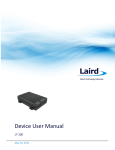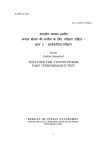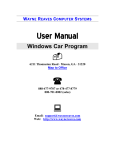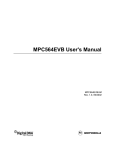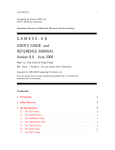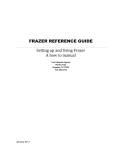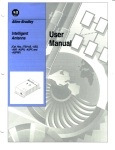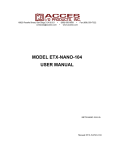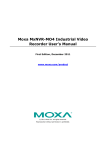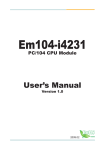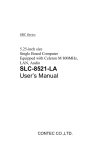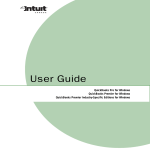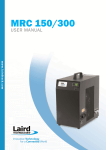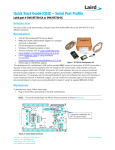Download Device User Manual
Transcript
Device User Manual LT-100 May 18, 2015 Table of Contents 1. 2. 3. Introduction ...............................................................................................................................4 1.1 Scope ............................................................................................................................................. 4 1.2 Audience ....................................................................................................................................... 4 1.3 Reference ...................................................................................................................................... 4 1.4 Applicable Products ...................................................................................................................... 4 Quick Start .................................................................................................................................5 2.1 Connecting the LT-100 .................................................................................................................. 5 2.2 Connector Pinouts......................................................................................................................... 5 2.3 Serial Communication ................................................................................................................... 6 Device General Operation ...........................................................................................................7 3.1 Command Summary ..................................................................................................................... 9 DIAG ................................................................................................................................................ 10 Reset Commands ............................................................................................................................ 13 SET ................................................................................................................................................... 14 LOCATE ............................................................................................................................................ 14 4. 3.2 Periodic Report ........................................................................................................................... 15 3.3 Event Report ............................................................................................................................... 15 Device Features ........................................................................................................................ 16 4.1 Geo-Fence ................................................................................................................................... 16 4.2 Cellular ........................................................................................................................................ 19 4.2.1 4.3 SMS ..................................................................................................................................... 19 General Purpose Input/ Output .................................................................................................. 20 4.3.1 Relay/Starter Enable and Disable ....................................................................................... 20 4.3.2 Emergency Starter Override ............................................................................................... 21 4.3.3 Manual Starter Override ..................................................................................................... 21 4.3.4 Buzzer/ Audible Warning .................................................................................................... 21 2 ©2015 Laird Technologies This document contains proprietary and confidential information of Laird Technologies and shall not be used, disclosed, or reproduced, in whole or in part, without the prior written consent of Laird Technologies 4.4 Accelerometer............................................................................................................................. 22 4.4.1 4.5 Over the Air Firmware Update.................................................................................................... 22 4.6 Device Diagnostics ...................................................................................................................... 23 4.6.1 5. Towing Detection ................................................................................................................ 22 LED Indication ..................................................................................................................... 23 Revision History........................................................................................................................ 24 3 ©2015 Laird Technologies This document contains proprietary and confidential information of Laird Technologies and shall not be used, disclosed, or reproduced, in whole or in part, without the prior written consent of Laird Technologies 1. Introduction 1.1 Scope This document describes the general operation and features provided of the Laird LT-100 device. Laird LT-100 vehicle& asset tracking device is a completely stand-along product that contains: control circuitry, microcontroller, cellular modem, GPS receiver, cellular antenna, GPS antenna, accelerometer, discrete I/O, and firmware all assembled into a compact plastic enclosure. The LT-100 is GSM/CDMA based reliable solutions for vehicle tracking, asset monitoring, and fleet management markets. 1.2 Audience This document is intended for Laird’s customer or backend integrator whom used Laird’s LT-100 as part of the solution. 1.3 Reference The following document contains additional information which clarifies or further describes the Laird STEL Protocol used by LT-100 device: Table 1-1: Reference Document Number Document Version Date 1 2.0.10 April 22, 2015 Laird Base64 STEL Protocol 1.4 Applicable Products Table 1-2: Applicable Products Product Number 63615 63617 63623 63625 SP 3202 TBD Product Detail CDMA version 2G GSM version 3G GSM version Brazil 2G GSM version Customer version Other customer version 4 ©2015 Laird Technologies This document contains proprietary and confidential information of Laird Technologies and shall not be used, disclosed, or reproduced, in whole or in part, without the prior written consent of Laird Technologies 2. Quick Start 2.1 Connecting the LT-100 The device operates in 6 V-16 V range and protects against over-voltage surges. For 2- wire or virtual ignition detection, the LT-100 device will detect ignition using an internal algorithm. 2.2 Connector Pinouts The LT-100 device has an 8- pin connector for power connection and I/Os. The device also has 2 LEDs; the blue LED indicates the status of cellular connection, while the green LED indicates the status of GPS fix. Table 2-1: 8-Pin Connector Pin Number with Names Pin Number Name 1 Digital Output 1 2 Digital Output 2 3 Analog Input 1 4 Ground 5 Ignition 6 Serial Port RX 7 Serial Port TX 8 Power Figure 2-1: 8-Pin Connector Pin-out 5 ©2015 Laird Technologies This document contains proprietary and confidential information of Laird Technologies and shall not be used, disclosed, or reproduced, in whole or in part, without the prior written consent of Laird Technologies 2.3 Serial Communication The LT-100 allows communicating to device for debugging purpose via a TTL to USB connection. For debug purpose, the user can use any terminal program to set up the communication with bellowing settings: Figure 2-3: Terminal settings Once the terminal is configured successfully, it will display the device debug prints. Communicate with the device using serial or STEL commands. The serial command will be in lowercase only, while using the STEL in debug mode should include a “.” (dot) in front of every command. Example: diag .DIAG 6 ©2015 Laird Technologies This document contains proprietary and confidential information of Laird Technologies and shall not be used, disclosed, or reproduced, in whole or in part, without the prior written consent of Laird Technologies 3. Device General Operation The LT-100 device’s normal operation begins after installation at a qualified service center. Once installed in a vehicle the device is ready for operation as defined below: Send location and event reports using the STEL communication protocol. The STEL protocol is defined in the STEL interface document. Communication with the backend server via an IP message (UDP/TCP) or an SMS text message. These messages will only be accepted from approved addresses/phone numbers loaded into configuration file. The device expects an acknowledgement for every message it transmits to the server. If the acknowledgement is not received by the device then device will resend the same message after a predefined timeout period until it successfully receives an acknowledgement from the server. When cellular coverage is not available then the device will store reports/events internally. When the cellular coverage is available again, the device will send the saved reports/Events. For messages that have customer configurable variables (i.e. max speed) that are numbers, the device will store maximum and minimum values. The device will have the ability to check if the customer inputted variable fits within the maximum and minimum values and reject messages with outliers. If the variable is a text string (i.e. an IP address) the device will not be able to do any validation. In the cases where a variable is user configurable, the goal is to limit the device to two or three pre-defined values. For example, if the variable is stationary time (time vehicle is static prior to a park message being sent), the presets could be 30 minutes, 60 minutes and 120 minutes. The device will acknowledge every command it receives from the server. The device will respond to a request for location with a location report. The device will allow the server to update/change configurations. 7 ©2015 Laird Technologies This document contains proprietary and confidential information of Laird Technologies and shall not be used, disclosed, or reproduced, in whole or in part, without the prior written consent of Laird Technologies The device will send a daily Heartbeat location report. The heartbeat frequency will be once every 25 hours (by default) and will include latitude, longitude, date, time and device ID, the heartbeat frequency can be configurable by customers among a choice of presets. The device will send a Parking alert event when the vehicle has been stationary for more than one hour which will include the device location. The parking alert should be able to toggle on and off, and the “stationary time” prior to alert should be configurable among a choice of presets. The device will support Circular and Polygon Geofences. The server administrator can add/modify/delete any Geofence The device will check for Geofence events every 1 minute. The device will send a Geofence alert every time the vehicle transitions from inside to outside of the fence or vice versa. When the Ignition is Off: When the Ignition is OFF the device shifts to low current draw / low power mode. GPS is on all the time. To optimize the power in battery mode or low current draw mode, the GPS can be put in sleep mode in ignition off mode and periodically wake up to sync the almanac. With GPS on all the time, device supports location feedback within 20 seconds of wake up. Support over the air updates. The server will acknowledge all the valid messages that are received from the device in the following syntax: ACK <sequence number> Sequence number the sequence number of the data received being acknowledge 8 ©2015 Laird Technologies This document contains proprietary and confidential information of Laird Technologies and shall not be used, disclosed, or reproduced, in whole or in part, without the prior written consent of Laird Technologies 3.1 Command Summary The format and syntax of all commands and responses are identical whether they are sent or received using SMS or UDP. The STEL protocol is used to communicate and interface with Laird cellular-GPS tracking and fleet management devices. The following rules apply to all remote commands: 1. All commands are in ASCII-text form and do not need a special termination character for the command string. 2. Commands to be issued in UPPERCASE only (commands given in lowercase will be ignored/no answer) 3. When commands are sent from the server to the device, the device will ACK/NACK received commands. 4. Valid commands will be acknowledged by server. An ACK message is received in the form: <ESN>,ACK,<command text> 5. Invalid commands will not be acknowledged. A negative Acknowledge is received in the form: <ESN>,NACK,<command text> 6. The general command (CMD) format is: 7. CMD<space><optional parameters separated by Comma>; (semicolon termination optional) 8. Commands can come via three modes: (Serial, SMS or Server). The ACK shall use the same communication mode (Serial, SMS, Server) as the original message. Table 3-1: Command Summary Number Command Comment 1 DIAG* Retrieve Diagnostic 2 SDIAG SMS Diagnostic Info over SMS 3 SHOWALL* Retrieve current settings 4 SET Modify configuration variables that are part of second configuration set which resides on EEPROM 5 CFENCEADD Add a circular geo- fence 6 PFENCEADD Add a polygon geo-fence 7 FENCEDEL Delete geo-fence 9 ©2015 Laird Technologies This document contains proprietary and confidential information of Laird Technologies and shall not be used, disclosed, or reproduced, in whole or in part, without the prior written consent of Laird Technologies 8 FENCEDELALL Delete all geo-fences 9 FENCELSTALL* List all geo-fences 10 BUZZWARN Trigger Relay Driver 11 STARTERDIS Disable the engine starter is toggled ON 12 STARTERENA Disables the engine starter is toggled OFF 13 REPOENA Repo mode is toggled ON 14 REPODIS Repo mode is toggled OFF 15 LOCATE Returns the current location of a device 16 ACK ACK with a parameter that has sequence number of previous message. 17 UPDATE OTA firmware update to a new version 18 GETIOSTATUS* Returns the current status of IO 19 EMERGENCYENA Enables Emergency Starter Override. 20 CARALARMENA Sets INP3 to detect car alarms 21 CARALARMDIS Resets INP3 to normal behavior 22 MODO Set the Odometer 23 PRINT Print the data on the UART interface DIAG To retrieve the current device status (Software Version, Bootloader Version, Hardware version, ICCID, IMEI , APN, GSM signal Strength, network registration information, Car battery voltage, Ignition voltage, Backup battery voltage, firmware version, ESN, Engine immobilization state, Logged packets information, latest location information): Sample DIAG response is as shown below. DIAG\r\n ESN:<ESN number>, SW:<version>,HW:<version>,BL:<version> \r\n IMEI:<number>, ISDN:<number>, APN:<string>\r\n CSIG:<number>, CREG:<status> , IP:<ip address>\r\n ASrv: <Server IP, port>\r\n 10 ©2015 Laird Technologies This document contains proprietary and confidential information of Laird Technologies and shall not be used, disclosed, or reproduced, in whole or in part, without the prior written consent of Laird Technologies IOStatus:<io status>, Vbat:<vehicle voltage>, Vign:<ignition voltage>, Vana:<analog input 1 voltage>\r\n Afix:<status>, dop:<number>, lat:<float>, long:<float>\r\n Uptime:<number>, Repo:<repomode>, LatePayment:<mode>, StarterDis:<status>, FPkts:<Number Buffered packets>, SPkts:<Number of sent packets>\r\n The complex message carries the following information. Device related info: ESN: Device unique serial number. This is used to identify and to address a device. SW: Device Software Version currently installed HW: Device Hardware Version BL: Device Boot-Loader Version Number Asrv: Server IP address, port number IOSTATUS: Status of the GPIO’s represented in 2 digit hexadecimal value. Each bit represents the state of a specific I/O as follows Bit8 = <IGN STATE> Bit7 = <INP1> Bit6 = <INP2> Bit5 = <INP3> Bit4 = <OUT1> Bit3 = <OUT2> Bit2 = <OUT3> Bit1 = <OUT4> If bit value is 0 = Low If bit value is 1 = High Vbat: Supply Voltage (Car Battery) Vana: Supply Voltage of Main Processor Vign: State of Ignition Signal on Ignition (Pin7 on the connector): 0 Volt is OFF; 12 Volt is ON Uptime: number of seconds from last device reboots FPkts: Number of Packets in flash waiting to be sent 11 ©2015 Laird Technologies This document contains proprietary and confidential information of Laird Technologies and shall not be used, disclosed, or reproduced, in whole or in part, without the prior written consent of Laird Technologies SPkts: Number of sent packets IPaddr: Device’s IP address ASrv: Destination Server IP address and port Repo: Repo Mode status. 1 if Repo mode is enabled, 0 if the Repo mode is disabled LatePayment: Late payment mode. 0 if late payment is enabled and 0 if it is disabled StarterDis: Starter disabled status. It is reported as 2-digit hexadecimal string. It is a bitwise field. Here is the how the bitwise definition of this status: Bit0 (lsb): Starter-disable Flag. 1- If Starter is disabled, 0- if Starter is enabled Bit 1: Emergency enable override status. 1- Emergency enabled is activated, 0 – Emergency enable is deactivated Bit 2: Manual Starter Override status. 1- MSO is activated, 0- MSO is deactivated Bit 7-3: Override hours count. Number of hours override (either MSO or emergency) remaining Modem related info: IMEI: IMEI number of the modem ISDN: Phone number of the activated CDMA modem IP: IP address of the cell modem ICCID: (integrated circuit card identifier). Sim Card Serial number printed on Sim Card. For CDMA this is not reported. APN: (Access Point Name). Provider specific name of an internet service access point for GPRS CSIG: Signal strength (0-31) converted into a dBm value. Range: (-113 dBm (0) to -53 dBm (31)). Invalid if signal strength is 85. CGREG: GPRS registration status (Internet). Not applicable to CDMA. Registration State Values: 0= not registered, modem is not looking for a network 12 ©2015 Laird Technologies This document contains proprietary and confidential information of Laird Technologies and shall not be used, disclosed, or reproduced, in whole or in part, without the prior written consent of Laird Technologies 1= registered to home-network; provider’s home-network 2= not registered, modem is currently trying to find a network to logon to 3= registration denied; Sim Card is not allowed to register on this network 4= unknown 5= registered at foreign network (roaming) CREG: GSM Registration Status. GSM registration status will use the same codes as above. GPS Receiver related info: Afix: Fix type dop: Dilution of Precision Value: 1=ideal, 2=excellent, 3-5=good, 6-10=moderate, 10-20=fair, >20=poor. GPS DOP will depend on current satellite positions and number of satellites. A larger value indicates the higher inaccuracy of a location calculation. Ideal value is 1. Reset Commands RESET Reboot the device RESET G Restart the GPS receiver RESET E Factory reset, all the configurations (like SET parameter configuration, Geo-Fence configurations) and Odometer counters are stored in device non-volatile memory called EEPROM. Upon receiving the “RESET E” command the device erase all non-volatile configurations Note: It is recommended to reset the unit using “RESET” command after performing a “RESET E”. RESET C Restart the cellular modem RESET H 13 ©2015 Laird Technologies This document contains proprietary and confidential information of Laird Technologies and shall not be used, disclosed, or reproduced, in whole or in part, without the prior written consent of Laird Technologies Clear all the logged/stored event messages SET The system has a set of configurable parameters that are defined in Table 8- SET Configuration Parameters. The device is shipped with factory default set of parameters as shown in the SET configuration table. These configurations can be changed using SET command. “RESET E” command will restore all set configuration parameters to factory default values. Command: SET Parameter=<value> Example: Use the following command to set APN, which is Access Point Name to m2m.tmobile.com SET APN=m2m.t-mobile.com It is possible to set multiple parameters in one command string, but the total string must not exceed 126 characters. Command: SET parameter1=value1, parameter2=value2……..parameter-n=value-n; Examples: SET PMN=10,PMF=60; SET IPD=’xxx.xxx.xxx.xxx’,PMF=20,PMN=10,IPU=’xxx.xxx.xxx.xxx’; Parameters are separated by “,” (comma) and the whole string is terminated by a “;”( semicolon), parameters have string for the value will start and terminate by single colon. LOCATE The following command will return the current location of a device as a comma-separated variable ASCII string. Command: LOCATE [SMS [number]] Channel: response channel via SMS 14 ©2015 Laird Technologies This document contains proprietary and confidential information of Laird Technologies and shall not be used, disclosed, or reproduced, in whole or in part, without the prior written consent of Laird Technologies Number: phone number the response is send to If no parameter/channel is given, then the module uses the configurable default method (DDC). Also, there are configurable default values for the default SMS phone. Example: “LOCATE” send LOCATE event to UDP or SMS based on DDC configuration “LOCATE SMS” will send LOCATE event via SMS to a default phone number specified in (PHN) “LOCATE SMS, 2345556789” Will send SMS to phone number 2345556789 3.2 Periodic Report The LT-100 device can be configured reporting in a time based interval for vehicle ignition on or off. The content of periodic message can be configured by STEL settings. Example: SET PMF=6 (set the periodic message during ignition OFF state to every 60 seconds) SET PMN=3 (set periodic message during ignition ON state to every 30 seconds) 3.3 Event Report The LT-100 device can be configured to send reports triggered by events in addition to the periodic report. The individual event reporting can be enabled or disabled by STEL settings. Please reference the Laird STEL Protocol Specification for each event type and enable. Example: SET EES=PNAIG Default EES=PNVAESIGX 15 ©2015 Laird Technologies This document contains proprietary and confidential information of Laird Technologies and shall not be used, disclosed, or reproduced, in whole or in part, without the prior written consent of Laird Technologies 4. Device Features 4.1 Geo-Fence The LT-100 device will support up to 5 circular fences and 5 polygonal fences, Circular fences are represented with radius and center location. Polygonal fences are represented with vertices. The maximum vertex supported by LT-100 is 10. Entering or leaving a user geo-fence causes an event or alert that can be transmitted. Whenever device enters or leaves a “Geo-fence”, the device reports GEOFENCE_ENTRY or GEOFENCE_EXIT, depending on which direction the fence is crossed. The device also supports one additional circular fence called “System Fence” that is used for Towing events. System fence will be set automatically when the vehicle is in parking state and disabled after the vehicle’s ignition has been detected. Add Circular Fences Command: CFENCEADD <ID>,<Delay>,<EVENTS>,<CENTER>,<RADIUS> ID: Fence Identifier (0 to 65535) DELEAY: Time (in seconds) that a vehicle has to be inside or outside of a fence for an event to be triggered EVENTS: Send events on entry and/or exit from fence 1 - Event on entry 2 - Event on exit 3 – Event on both entry and exit CENTER: fence center position Latitude and longitude in degree (float) RADIUS: Radius of circular geo-fence in 10meters units Example: To add a circular fence at 42.34676,-83.94323 and 1Km radius 16 ©2015 Laird Technologies This document contains proprietary and confidential information of Laird Technologies and shall not be used, disclosed, or reproduced, in whole or in part, without the prior written consent of Laird Technologies CFENCEADD 1001,5,3,42.34676,-83.94323,100 Add Polygon Fence Command: PFENCEADD <ID>,<DELAY>,<EVENTS>,<NUM_VERTICES>,<Vertex1>,<Vertex2>, ….<VertexN>, Required fields are: ID: Fence Identifier (0 to 65535). Note that circular fence id and polygon fence id should not be the same DELEAY: Time (in seconds) that a vehicle has to be inside or outside of a fence for an event to be triggered EVENTS: Send events on entry and/or exit from fence 1 - Event on entry 2 - Event on exit 3 – Event on both entry and exit NUM_VERTICES: Number of vertices of the polygon. A minimum of 3 and a maximum of 10 vertices are supported. VERTEX n: Location of vertex n of polygon. Vertex is a combination of <LAT,LONG> and it the location of vertex n Example: To add a polygon fence of 4 vertices PFENCEADD 1002,5,3,4,42.95466,-83.69831,42.95743,-83.55927,42.87546,-83.56579,42.87345,83.65334 Delete a User Fence Command: FENCEDEL <id> ID: Fence Identified as given with CFENCEADD or PFENCEADD 17 ©2015 Laird Technologies This document contains proprietary and confidential information of Laird Technologies and shall not be used, disclosed, or reproduced, in whole or in part, without the prior written consent of Laird Technologies Delete all user fences Command: FENCEDELALL List all user fences Command: FENCELSTALL Send all the user fences to the Data server via UDP. Sample response on the UDP data server is as shown below. ALLFENCES <number of Fences> <Page number>\r\n [1,<ID>,<TYPE>,<DELAY>,<EVENTS>,<CENTER>,<RADIUS>\r\n [2,<ID>,<TYPE>,<DELAY>,<EVENTS>,<CENTER>,<RADIUS>\r\n [3,<ID>,<TYPE>,<DELAY>,<EVENTS>,<CENTER>,<RADIUS>\r\n [4,<ID>,<TYPE>,<DELAY>,<EVENTS>,<CENTER>,<RADIUS>\r\n [5,<ID>,<TYPE>,<DELAY>,<EVENTS>,<CENTER>,<RADIUS>\r\n ALLFENCES <number of Fences> <Page number>\r\n [6,<ID>,<TYPE>,<DELAY>,<EVENTS>,<NUM_VERTEX>,<VERTEX_1>,..<VERTEX_N>\r\n [7,<ID>,<TYPE>,<DELAY>,<EVENTS>,<NUM_VERTEX>,<VERTEX_1>,..<VERTEX_N>\r\n [8,<ID>,<TYPE>,<DELAY>,<EVENTS>,<NUM_VERTEX>,<VERTEX_1>,..<VERTEX_N>\r\n [9,<ID>,<TYPE>,<DELAY>,<EVENTS>,<NUM_VERTEX>,<VERTEX_1>,..<VERTEX_N>\r\n [10,<ID>,<TYPE>,<DELAY>,<EVENTS>,<NUM_VERTEX>,<VERTEX_1>,..<VERTEX_N>\r\n A Center or a Vertex is a location represented as combination of Latitude and Longitude separated by a comma “,” 18 ©2015 Laird Technologies This document contains proprietary and confidential information of Laird Technologies and shall not be used, disclosed, or reproduced, in whole or in part, without the prior written consent of Laird Technologies Table 4-1: User Fences Specification Field ID Size and Units 2bytes TYPE 1byte Min Max Description 1 65535 Unique ID to the device representing fence ID 1 2 Fence type 1 – Circular 2 - Polygon DELAY 1 byte, seconds 1 240 EVENTS 1 byte 1 3 Fence Event Entry/Exit delay in seconds Fence event type 1 – Fence Enter 2 – Fence Exit 3- Both Fence Exit and Fence Enter Center Position (lat,long) N/A N/A Center position (Latitude and longitude) of the Circular fence Radius Word, units 10m 1 10000 Num_Vertex 1byte, 3 10 Radius of the Circular Fence Number of vertices of the polygon Example 10 vertices. Minimum 3 Vertices and Maximum 10 Vertex X Position (lat,long) N/A N/A Latitude and Longitude of Vertex X 4.2 Cellular 4.2.1 SMS The device is able to send SMS message to both server query and SMS query. Command: SDIAGQ SMS [<phone number>] To retrieve minimal diagnostic information over SMS. Below is the response sample. <ESN>,SDIAG,<software version>,<APN name>,<active data server IP>,<active data server UDP port>,<Vehicle Battery Voltage>,<CGREG>,<Number of Flash Packets stored>,<Device Uptime in 19 ©2015 Laird Technologies This document contains proprietary and confidential information of Laird Technologies and shall not be used, disclosed, or reproduced, in whole or in part, without the prior written consent of Laird Technologies seconds>,<Cell modem uptime from last modem reset>,<Number of Cell modem resets>, <IPAddress>, <IO status>, GPS status(Valid/Invalid), Afix, DOP, Lat, Long LOCATE SMS [number] To retrieve locate information over SMS. Note: the LCOATE response is sending in binary format, the response needs to be decoded to get the information. 4.3 General Purpose Input/ Output The device has 4 digital outputs, 3 analog inputs, and 3 digital inputs. The bellowing command will check the IO status of all the digital and analog inputs. It also reports the current state of the digital outputs. Command: GETIOSTATUS Response: <ESN>,IOSTATUS,<IOSTATUS>,<ADC1>,<ADC2>,<ADC3> 4.3.1 Relay/Starter Enable and Disable The device will support the disabling of the vehicle engine starter for recovery purposes and also provide the capability to over-ride the disabled starter. The device will respond to a request to disable the vehicle by sending an acknowledgment to the request and sending the GPS position report at the time the request is received. Following the acknowledgement and reporting to the Disable request then check if the conditions for disable the starter are present. Conditions for disable are: o Ignition is OFF o Vehicle is in stationary o Cell Coverage presents o Valid GPS fix When the conditions are present send a GPS location report and disable the engine starter. The disabled starter can also be Enabled by toggling the ignition key ON/OFF for a predefined period. STARTERDIS Disable the engine starter 20 ©2015 Laird Technologies This document contains proprietary and confidential information of Laird Technologies and shall not be used, disclosed, or reproduced, in whole or in part, without the prior written consent of Laird Technologies STARTERENA Re-enable the engine starter 4.3.2 Emergency Starter Override The following command will override the starter disable feature for 24 hours. Command: ENERGENCYENA 4.3.3 Manual Starter Override The device will support a manual override of the starter-disable feature by performing a pre-defined number of ignition cycles (Ignition On ->Ignition Off ->Ignition On). Manual override will have following features: MSO feature will be enabled whenever the vehicle is in starter-disabled state. There will be a manual override counter to track and determine the number of times this feature gets used. o The counter will decrement with each MSO usage. o When the counter reaches 0, manual override will be disabled. In order to initiate an ignition On/Off cycle, the ignition needs to be off for 15 seconds. Manual override require the following key sequence to re-enable the starter: o When the counter is 2: 5 Ignition cycles within 5 seconds o When the counter is 1: 7 Ignition cycles The manual override counter can also be reset using configuration parameter. “EMERGENCYENA” command will override MSO feature. 4.3.4 Buzzer/ Audible Warning For late payment warning in BHPH application, device will trigger to indicate a late payment warning under bellowing condition: Ignition cycle will trigger event Output signal to external noisemaker Signal will be periodic: o On for 1 second o Off foe 1 second o It will be activated for BWP period 21 ©2015 Laird Technologies This document contains proprietary and confidential information of Laird Technologies and shall not be used, disclosed, or reproduced, in whole or in part, without the prior written consent of Laird Technologies Command: BUZZWARN <0/1> 0- Disable 1- Enable 4.4 Accelerometer The accelerometer is able to detect motion during ignition on and off states, and the device is able to provide raw accelerometer data at regular intervals. 4.4.1 Towing Detection The device will detect and report if the vehicle is being towed as defined below: Vehicle motion is detected via accelerometer. Vehicle theft/towing detection will be enabled when the ignition is turned OFF. Towing event is generated if there is a change in position that is more than a predefined limit during ignition OFF. 4.5 Over the Air Firmware Update The LT-100 is able to update the device firmware over the air without physically access to the device. Command: SET IPU=<IP address of update server> SET OTA=1 UPDATE <Firmware version> 22 ©2015 Laird Technologies This document contains proprietary and confidential information of Laird Technologies and shall not be used, disclosed, or reproduced, in whole or in part, without the prior written consent of Laird Technologies Firmware Version Firmware version that needs to be downloaded. This could be filename as well but that depends on the OTA update server implementation On UPDATE command, device downloads the firmware from the specified server and boots up with the new firmware. In case the update process stops in between due to server going down while the update is in progress or due to unavailability of GPRS connection; devices will boot up with a factory programmed fail safe firmware. Note: During the update stage, device will not be reachable by server command. 4.6 Device Diagnostics 4.6.1 LED Indication The device has 2 LEDs for connection status indication. Green LED indicates the GPS status, and the Blue LED indicates the cellular status. Table-11 describes the blinking patterns for the two LEDs. Table 4-3: LED Patterns LED SOLID GREEN (GPS) Device has a valid GPS fix Device established cellular connection BLUE (Cell) Blink Once Every 2 Seconds GPS is trying to acquire a valid fix Modem is trying to establish a connection with network Blink Thrice Every 2 Seconds NA SIM card is not present Both LED Blink in the Same Pace Device is in Bootloader mode, not able for communication 23 ©2015 Laird Technologies This document contains proprietary and confidential information of Laird Technologies and shall not be used, disclosed, or reproduced, in whole or in part, without the prior written consent of Laird Technologies 5. Revision History VERSION CHANGES DATE NAME 0.1 Initial draft version April 28, 2015 Ying Li 1.0 First released revision May 18, 2015 Ying Li 24 ©2015 Laird Technologies This document contains proprietary and confidential information of Laird Technologies and shall not be used, disclosed, or reproduced, in whole or in part, without the prior written consent of Laird Technologies
























